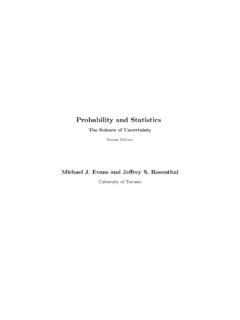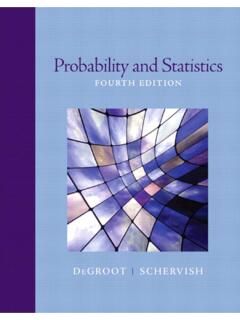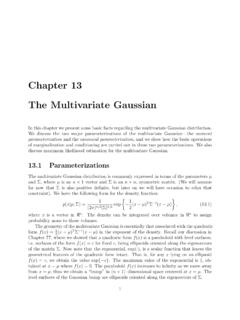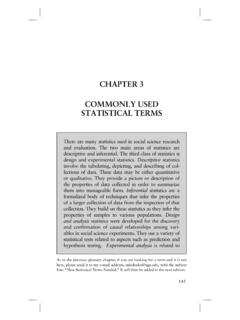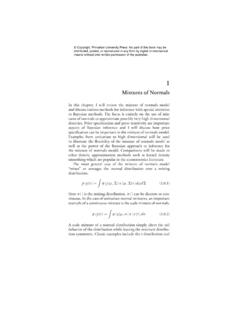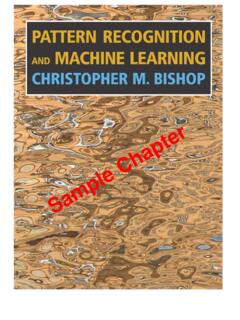Transcription of Introduction to Probability and Statistics Using R
1 Introduction to Probabilityand Statistics UsingRG. Jay KernsFirstEditioniiIPSUR: Introduction to Probability and Statistics UsingRCopyright 2010 G. Jay KernsISBN: 978-0-557-24979-4 Permission is granted to copy, distribute and/or modify this document under the terms of theGNU Free Documentation License, Version or any later version published by the FreeSoftware Foundation; with no Invariant Sections, no Front-Cover Texts, and no Back-CoverTexts. A copy of the license is included in the section entitled GNU Free DocumentationLicense .Date: July 28, 2010 ContentsPrefaceviiList of FiguresxiiiList of Tablesxv1 An Introduction to Probability and Probability .. Statistics .. 1 Chapter Exercises.. 32 An Introduction Downloading and InstallingR.
2 Communicating withR.. BasicROperations and Concepts.. Getting Help.. External Resources.. Other Tips.. 16 Chapter Exercises.. 173 Data Types of Data.. Features of Data Distributions.. Descriptive Statistics .. Exploratory Data Analysis.. Multivariate Data and Data Frames.. Comparing Populations.. 47 Chapter Exercises.. 534 Sample Spaces.. Events.. Model Assignment.. Properties of Probability .. Counting Methods.. Conditional Probability .. Independent Events.. Bayes Rule.. Random Variables.. 102 Chapter Exercises.. 105iiiivCONTENTS5 Discrete Discrete Random Variables.. The Discrete Uniform Distribution.. The Binomial Distribution.
3 Expectation and Moment Generating Functions.. The Empirical Distribution.. Other Discrete Distributions.. Functions of Discrete Random Variables.. 130 Chapter Exercises.. 1326 Continuous Continuous Random Variables.. The Continuous Uniform Distribution.. The Normal Distribution.. Functions of Continuous Random Variables.. Other Continuous Distributions.. 150 Chapter Exercises.. 1557 Multivariate Joint and Marginal Probability Distributions.. Joint and Marginal Expectation.. Conditional Distributions.. Independent Random Variables.. Exchangeable Random Variables.. The Bivariate Normal Distribution.. Bivariate Transformations of Random Variables.. Remarks for the Multivariate Case.
4 The Multinomial Distribution.. 178 Chapter Exercises.. 1808 Sampling Simple Random Samples.. Sampling from a Normal Distribution.. The Central Limit Theorem.. Sampling Distributions of Two-Sample Statistics .. Simulated Sampling Distributions.. 189 Chapter Exercises.. 1919 Point Estimation.. Confidence Intervals for Means.. Confidence Intervals for Differences of Means.. Confidence Intervals for Proportions.. Confidence Intervals for Variances.. Fitting Distributions.. Sample Size and Margin of Error.. Other Topics.. 214 Chapter Exercises.. 215 CONTENTSv10 Hypothesis Introduction .. Tests for Proportions.. One Sample Tests for Means and Variances.. Two-Sample Tests for Means and Variances.
5 Other Hypothesis Tests.. Analysis of Variance.. Sample Size and Power.. 230 Chapter Exercises.. 23211 Simple Linear Basic Philosophy.. Estimation.. Model Utility and Inference.. Residual Analysis.. Other Diagnostic Tools.. 259 Chapter Exercises.. 26612 Multiple Linear The Multiple Linear Regression Model.. Estimation and Prediction.. Model Utility and Inference.. Polynomial Regression.. Interaction.. Qualitative Explanatory Variables.. PartialFStatistic.. Residual Analysis and Diagnostic Tools.. Additional Topics.. 292 Chapter Exercises.. 29613 Resampling Introduction .. Bootstrap Standard Errors.. Bootstrap Confidence Intervals.. Resampling in Hypothesis Tests.. 305 Chapter Exercises.
6 30914 Categorical Data Analysis31115 Nonparametric Statistics31316 Time Series315 ARSession Information317B GNU Free Documentation License319C History327D Data Structures.. Importing Data.. Creating New Data Sets.. Editing Data.. Exporting Data.. Reshaping Data.. 337E Mathematical Set Algebra.. Differential and Integral Calculus.. Sequences and Series.. The Gamma Function.. Linear Algebra.. Multivariable Calculus.. 347F Writing Reports What to Write.. How to Write It withR.. Formatting Tables.. Other Formats.. 353G Instructions for Generating This Document.. How to Use This Document.. Ancillary Materials.. Modifying This Document.. 357 HRcmdrTestDriveStory359 Bibliography363 Index369 PrefaceThis book was expanded from lecture materials I use in a one semester upper-division under-graduate course entitledProbability and Statisticsat Youngstown State University.
7 Those lec-ture materials, in turn, were based on notes that I transcribed as a graduate student at BowlingGreen State University. The course for which the materials were written is 50-50 Probabil-ity and Statistics , and the attendees include mathematics,engineering, and computer sciencemajors (among others). The catalog prerequisites for the course are a full year of book can be subdivided into three basic parts. The first part includes the introductionsand elementarydescriptive Statistics ; I want the students to be knee-deep in data right out ofthe gate. The second part is the study ofprobability, which begins at the basics of sets andthe equally likely model, journeys past discrete/continuous random variables, and continuesthrough to multivariate distributions.
8 The chapter on sampling distributions paves the way tothe third part, which isinferential Statistics . This last part includes point and interval estimation,hypothesis testing, and finishes with introductions to selected topics in applied usually only have time in one semester to cover a small subset of this book. I cover thematerial in Chapter 2 in a class period that is supplemented by a take-home assignment forthe students. I spend a lot of time on Data Description, Probability , Discrete, and ContinuousDistributions. I mention selected facts from MultivariateDistributions in passing, and discussthe meaty parts of Sampling Distributions before moving right along to Estimation (which isanother chapter I dwell on considerably).
9 Hypothesis Testing goes faster after all of the previouswork, and by that time the end of the semester is in sight. I normally choose one or two finalchapters (sometimes three) from the remaining to survey, and regret at the end that I did nothave the chance to cover an attempt to be correct I have included material in this book which I would normally notmention during the course of a standard lecture. For instance, I normally do not highlight theintricacies of measure theory or integrability conditionswhen speaking to the class. Moreover, Ioften stray from the matrix approach to multiple linear regression because many of my studentshave not yet been formally trained in linear algebra. That being said, it is important to me forthe students to hold something in their hands which acknowledges the world of mathematicsand Statistics beyond the classroom, and which may be usefulto them for many semesters tocome.
10 It also mirrors my own experience as a vision for this document is a more or less self contained,essentially complete, correct,introductory textbook. There should be plenty of exercisesfor the student, with full solutionsfor some, and no solutions for others (so that the instructormay assign them for grading).BySweave s dynamic nature it is possible to write randomly generatedexercises and I hadplanned to implement this idea already throughout the , there are only 24 hours in aday. Look for more in future readers will be able to detect my origins: Probability and Statistical Inferenceby Hogg and Tanis [44],Statistical Inferenceby Casella and Berger [13], andTheory of PointEstimation/Testing Statistical Hypothesesby Lehmann [59,58].
